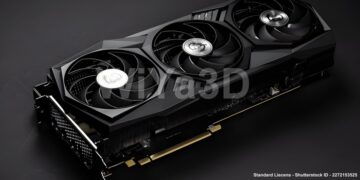When it comes to CAD (Computer-Aided Design) modeling, selecting the right processor (CPU), it’s important for achieving smooth performance, fast rendering times, and efficient multitasking. The processor serves as the brain of your computer, determining how quickly and effectively it can handle complex calculations, 3D modeling, simulations, and other tasks integral to CAD work. With a wide variety of processors available from Intel, AMD and Apple such as Intel’s i3, i5, i7, i9, and AMD’s Ryzen 5, 7, 9, and Apple M1 & M2 series, choosing the best one for your needs can be daunting. This article breaks down these processors and helps you select the best option for your CAD software.
Understanding Intel Processors for CAD Modeling
-
Intel Core i3:Entry Level Option The Intel Core i3 is an entry-level processor that is suitable for basic tasks like web browsing, office applications, and light multitasking. For CAD modeling, particularly in professional environments, an i3 processor may not provide the necessary power and speed to handle complex models or large datasets efficiently. It is more suited for 2D CAD work or very basic 3D modeling.
-
Intel Core i5: Mid Range Option The Intel Core i5 is a mid-range processor that offers a balanced performance for everyday tasks and some light to moderate CAD work. It has more cores and higher clock speeds than the i3, making it suitable for less demanding 3D CAD applications. However, it may struggle with high-end CAD tasks, such as large assemblies or intensive rendering.
-
Intel Core i7: Professional & High Performance The Intel Core i7 is a high-performance processor ideal for most CAD applications. With more cores, higher clock speeds, and larger cache sizes than the i5, the i7 can handle complex 3D modeling, simulations, and multitasking with ease. It is a popular choice among CAD professionals who need a good balance between cost and performance.
-
Intel Core i9: Top of The Line Performance The Intel Core i9 is the most powerful processor in Intel’s consumer lineup, designed for high-end, professional-grade workloads. With even more cores, higher clock speeds, hyper-threading capabilities, and larger caches, the i9 is perfect for demanding CAD tasks, including real-time simulations, rendering, and working with large assemblies. It is best suited for professional designers, architects, and engineers who work with complex models and require top-tier performance.
Intel Processor Generations
Each Intel processor series comes in multiple generations, with each new generation offering improvements in performance, efficiency, and technology:
-
10th Generation (Comet Lake): Introduced improved performance and efficiency, but lacks support for PCIe 4.0.
-
11th Generation (Rocket Lake): Brought better integrated graphics (Intel Iris Xe) and improved single-threaded performance.
-
12th Generation (Alder Lake): A major leap in performance with a new hybrid architecture combining high-performance cores and high-efficiency cores, as well as support for DDR5 RAM and PCIe 5.0.
-
13th Generation (Raptor Lake): Builds on Alder Lake with enhanced core counts, clock speeds, and better energy efficiency.
For CAD applications, it’s generally recommended to choose the latest generation you can afford, as they provide better performance per watt and improved multitasking capabilities.
Understanding AMD Ryzen Processors for CAD Modeling
AMD’s Ryzen processors have gained popularity for their strong multi-core performance and competitive pricing. Here’s a breakdown of AMD Ryzen CPUs:
-
-
Ryzen 5: Solid Mid Range Performer The AMD Ryzen 5 is a mid-range processor that competes with Intel’s i5 series. With more cores and threads than a comparable i5, Ryzen 5 can handle light to moderate CAD work effectively. It’s a good choice for small businesses or individual designers working with less demanding 3D models or 2D drafting.
-
Ryzen 7: High Performance Option The Ryzen 7 offers more cores and threads than the Ryzen 5, making it a great choice for most CAD applications. It provides excellent multitasking capabilities, faster rendering, and better performance in complex modeling tasks. The Ryzen 7 is a solid choice for professional CAD users who need a balance between cost and performance.
-
Ryzen 9: Extreme Multitasking & Performance The Ryzen 9 is designed for high-end computing tasks and can compete directly with Intel’s i9 series. With even more cores and threads, the Ryzen 9 excels in heavy-duty CAD workloads, such as large assemblies, real-time simulations, and rendering tasks. It’s an ideal choice for professional CAD users who require maximum performance.
-
Ryzen Threadripper: While not mentioned in the initial request, it’s worth noting that the Ryzen Threadripper series is a powerhouse for extreme workloads. These CPUs offer up to 64 cores and 128 threads, making them perfect for the most demanding CAD applications, large-scale simulations, and rendering farms.
-
AMD Processor Generations
AMD processors also come in different generations, each improving on the last in terms of performance and efficiency:
-
-
Ryzen 2000 Series (Zen+): Improved power efficiency and performance over the first-generation Ryzen.
-
Ryzen 3000 Series (Zen 2): A significant leap in performance with more cores, better multi-threading, and PCIe 4.0 support.
-
Ryzen 5000 Series (Zen 3): Offers further performance gains, especially in single-threaded tasks, and improved power efficiency.
-
Ryzen 7000 Series (Zen 4): The latest generation brings DDR5 support, PCIe 5.0 compatibility, and substantial improvements in processing power and efficiency.
-
Apple Processors: M1 and M2
Apple M1: Efficient and Powerful
-
-
-
Overview: The M1 is Apple’s first ARM-based processor for Macs, known for its excellent power efficiency and strong single-core performance. It integrates CPU, GPU, and Neural Engine on a single chip, offering smooth performance for many tasks.
-
Best For: Light to medium CAD work, especially for users in the Apple ecosystem.
-
Limitations: Limited to software that is optimized for Apple’s architecture; lacks compatibility with some CAD applications traditionally run on Windows.
-
-
Apple M2: Next-Gen Apple Silicon
-
-
-
Overview: The M2 processor builds upon the M1, providing better performance and power efficiency. It is designed to handle more demanding tasks, including moderate CAD work.
-
Best For: Medium-level CAD modeling and some 3D rendering tasks in macOS-optimized software.
-
Limitations: Similar limitations as the M1 in terms of software compatibility outside the Apple ecosystem.
-
-
Key Factors in Choosing a Processor for CAD
-
Software Requirements: Different CAD software may have specific hardware recommendations. For example, AutoCAD and SOLIDWORKS benefit from high single-thread performance, while Revit and 3ds Max benefit from multi-core processors.
-
Core Count and Threads: More cores and threads allow for better multitasking and faster performance in multi-threaded tasks like rendering. For heavy 3D modeling or rendering, consider a processor with at least 8 cores (such as the Intel i7 or AMD Ryzen 7).
-
Clock Speed: Higher clock speeds (measured in GHz) improve performance in single-threaded tasks, which are common in many CAD applications. Processors like the Intel i9 and AMD Ryzen 9 offer high clock speeds for enhanced performance.
-
Cache Size: Larger cache sizes allow the CPU to access frequently used data faster, improving performance in complex CAD tasks.
-
Compatibility: Ensure that the processor is compatible with your motherboard and other components, such as RAM. Check for socket types and supported RAM speeds (DDR4 vs. DDR5).
-
Multitasking Needs: If you run multiple applications simultaneously (e.g., CAD software, rendering tools, browsers), a processor with more cores and threads (like Ryzen 9 or Core i9) may be more beneficial.
-
Power Consumption and Cooling: High-performance processors consume more power and generate more heat. Ensure your system has adequate cooling and a power supply to support the chosen CPU.
-
Future-Proofing: Investing in a more powerful processor may save money in the long run by extending the lifespan of your workstation and handling future software updates.
-
Budget: Your budget will also play a significant role in your choice. For entry-level or mid-range CAD work, an Intel i5 or Ryzen 5 might suffice. For more professional workloads, consider the Intel i7, i9, or Ryzen 7, 9 series.
Best Processors for CAD Modeling
Best Entry-Level Processors:
-
-
Intel Core i5-12600K: A solid choice for moderate 3D modeling and 2D drafting.
-
AMD Ryzen 5 5600X: Offers excellent performance for the price, suitable for light to moderate CAD work.
-
Best Mid-Range Processors:
-
-
Intel Core i7-13700K: Great for most CAD applications, providing a balance between cost and performance.
-
AMD Ryzen 7 5800X: Ideal for complex 3D modeling, simulations, and multitasking.
-
Best High-End Processors:
-
-
Intel Core i9-13900K: Perfect for demanding CAD workloads, including rendering and large assemblies.
-
AMD Ryzen 9 5900X or 7950X: Offers top-tier performance for complex CAD tasks, including heavy simulations and rendering.
-
Apple Ecosystem Users: Apple M1 or M2, depending on software compatibility and CAD workload requirements.
Conclusion
Choosing the right processor for CAD modeling depends on your specific needs, budget, and the complexity of your projects. While both Intel and AMD offer excellent options across different price points, the key is to find a balance between core count, clock speed, cache size, and your software requirements. Opt for a newer generation processor to benefit from improved performance and efficiency.







